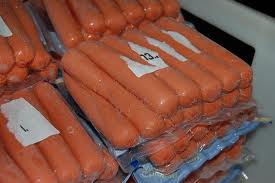Effects of egg albumen as binder, on yield and sensory characteristics of frankfurter sausages
Keywords:
Binder, Egg albumen, Polyphosphates, Comminuted meat productsAbstract
This study was conducted to find alternative binders to substitute for polyphosphate in frankfurter-type sausages. Fresh albumen (FA) at 32.5 (FA1), 49 (FA2) and 65 (FA3) g/kg meat (equivalent to 5, 7.5 and 10g dry matter/kg meat), and dried albumen (DA) at 5 (DA1), 7.5 (DA2) and 10 (DA3) g/kg meat were used to formulate the products, and compared with those formulated with polyphosphate (5g/kg meat) as binder. The Completely Randomized Design was used, and products were formulated in triplicates. They were vacuum-packed in transparent packaging bags and stored at 2°C for sensory and laboratory analyses. From the results, egg albumen had no significant (P>0.05) effects on the cooking losses of the FA1, FA2, DA1 and DA2 products, but the losses in these products were significantly (P<0.01) lower than in the DA3 and FA3 products. The FA1 and FA2 products were juicier than the FA3, control, DA2 and DA3 products. The acceptability of the products was however, not significantly (P>0.05) different. The egg albumen however, increased the crude protein and reduced fat contents of the DA and FA products. It was cheaper acquiring egg albumen for the FA1 products than acquiring polyphosphates, but it’s more expensive acquiring dried albumen for the DA products, although the products had acceptable yield and sensory characteristics.
References
Acton, J., Dick, R., 1989. Functional roles of heat induced protein gelation in processed meat. In: Kinsella, W. and
Soucie, Editors, 1989. Food proteins, The American Oil Chemists Society, Champaign, IL, pp. 195–209.
AOAC International, 1999. In P. Cunniff (Ed.), Official methods of analysis of AOAC International (16th ed.).
Gaithersburg, MD, USA: AOAC International.
Barbut, S., 1995. Importance of fat emulsification and protein matrix characteristics in meat batter stability, J.
Muscl. Food. 6, 161–167.
Biesalski, H.K., 2005. Meat as component of a healthy diet; are there any risks or benefits if meat is avoided in the
diet? Meat Sci. 70, 509–524.
British Standard Institution, 1993. Assessors for sensory Analysis: Guide to Selection, Training and Monitoring of
Selected Assessors. BS 17667. British Standard Institute, London, United Kingdom.
Chen, T.C., Lu, G.H., 1999. Application of Egg-white and Plasma Powders as muscle food binding agents. J. Food
Engin. 42 (3), 147-151.
Desmond, E., 2006. Reducing salt: A challenge for the meat industry, Meat Science 74 (1), 188 - 196.
FAO, 1991. Meat Extenders: In: Guidelines for Slaughtering, Meat Cutting and Further Processing. Animal
Production and Health Paper, Rome, Italy No 91-170.
Ferguson, L.R., 2010. Meat and cancer. Meat Sci. 84, 308–313.
ICMSF, 1986. Microorganisms in foods. 2. Sampling for microbiological analysis: Principles and specific applications
(2nd ed.). Toronto: University of Toronto Press, Buffalo, NY
Kato, A., Hisham, R.I., Hiroyuki, W., Honma, K., Kobayashi, K., 1990. Structural and gelling properties of dry-heating
egg white proteins. J. Agri. Food Chem. 38, 32–37.
Keeton, J.T., 1983. Effect of fat and NaCl/phosphate levels on the chemical and sensory properties of pork patties.
J. Food Sci. 41, 878–881.
Lawrie, R.A., Ledward, D.A., 2006. The eating qualities of meat. In: Lawrie’s Meat Science, 7th edition, Woodhead
Publishing Limited, Abington Hall, Abington, Cambridge CB1 6AH, England. Pp 1 - 14.
Mancini, R.A., Hunt, M.C., 2005. Current research in meat colour, Meat Sci. 71 (1), 100–121.
McCarty, M.F., 2004. Should we restrict chloride rather than sodium? Med. Hypoth. 63, 138–148.
Means, W. J., Schmidt, G. R., 1987. Restructuring fresh meat without the use of salt or phosphate. In A. M. Person,
& T. R. Duston, Advances in meat research. vol. 3, Restructured meat and poultry products (pp. 469–487).
New York: AVI Book, Van Nostrand Reinhold
Minitab, 2007. Minitab Statistical Software, release 15 for Windows 95/98/2000 and Windows NT. Minitab Inc,
USA.
Pisula, A., Tyburcy, A., 1996. Hot processing of meat, Meat Sci. 43, 125-135.
Pond, W.G., Church, D.C., Pond, K.R., 1995. Nutrient metabolism. In: Basic animal nutrition and feeding. 4th edition,
John Willey and Sons, New York. Pp 67-247
Siegel, D.G., Church, K.E., Schmidt, G.R., 1979. Gel structure of non-meat proteins as related to their ability to bind
meat pieces. J. Food Sci. 44, 1276–1279.
Smith, D.P., Young, L.L., 2007. Marination pressure and Phosphate on fillet yield, tenderness and colour. Poult. Sci.
, 2666 – 2670.
Teye, G.A., 2010. The Meat Processing Industry in Ghana. Development Spectrum, 3 (1) 21-31.
Troy, D.J., Desmond, E.M. and Buckley, D.J., 1999. Eating quality of low-fat burgers containing fat replacing
functional blends. J. Food Sci.Agri. 79, 507–516.
USDA, 2007. Department of Agriculture, Agricultural Research Service. USDA National Nutrient Database for
Standard Reference, Release 20. Nutrient Data Laboratory Home Page
Warriss, P.D., 2010. Meat Hygiene, Spoilage and Preservation. In: Meat Science, An Introductory Text (2nd Edition).
CAB International, Wallingford Oxfordshire, UK. Pp 130 - 148
WHO (World Health Organization) Study Group, 1990. ‘Diet, Nutrition and the Prevention of Chronic Diseases’
WHO Technical Report Ser. 797.
Xiong, Y.L., 1997. Structure-function relationships of muscle proteins. In: Damodaran, S. and Paraf, A., Editors,
Food proteins and their applications, Marcel Dekker, New York, 341–392.

Published
How to Cite
Issue
Section
Copyright (c) 2012 M. Teye, G. A. Teye, F.N. A. Odoi

This work is licensed under a Creative Commons Attribution-NonCommercial-NoDerivatives 4.0 International License.



